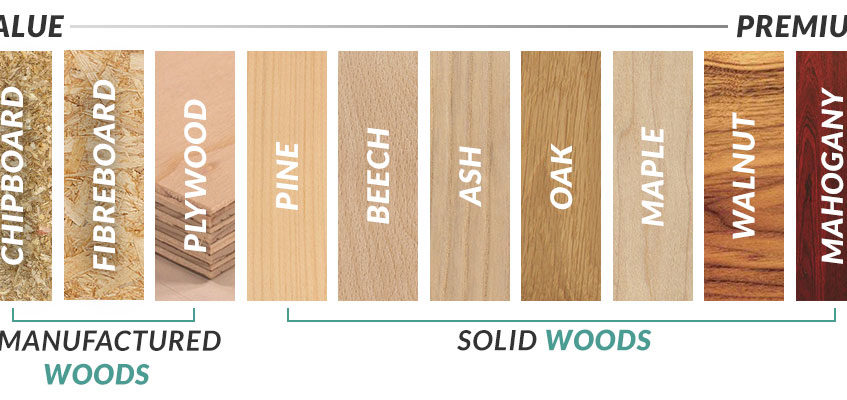Pine
Pine is an inexpensive, lightweight wood that can be yellowish or whitish with brown knots. It’s often used for rustic pieces, like farmhouse-style tables.
Pros: It’s low-cost, and it takes paint well, so it’s great for kids’ furniture. (The same holds true for birch and poplar.) Pine develops a nice, rustic patina from age and use, and it resists shrinking and swelling.
Cons: It’s a softwood, so it’s prone to scratches and dents.

Cherry
Cherry is a hardwood with a fine, straight grain that ranges from reddish brown to blond. It is often used for carved chairs but also shows up in clean-lined Shaker-style tables and cabinets.
Pros: It’s easily shaped, and it polishes well. Unstained, it has a rich, beautiful color.
Cons: It’s expensive. Sometimes the color darkens with age.

Maple
Maple is a creamy white hardwood that sometimes has a reddish tinge. One of the hardest wood species, maple is often chosen for heavy-use items, like dressers and kitchen cabinets.
Pros: Maple is affordable and ultra-durable. It can take a beating and look great for years. Because it takes dark stains well, maple is often stained to mimic a pricier wood, like cherry or mahogany (which is a controversial pick itself because of deforestation in the regions where it’s harvested).
Cons: If maple is not properly sealed first, the staining can look blotchy.

Oak
Oak is a hardwood that tends to be very grainy. There are two varieties: red oak, which ranges from light brown to pinkish red with a swirling, waterlike pattern, and white oak, which has a tiger-stripe grain with yellow rays and flecks. Oak is often used in pieces made in the Arts and Crafts or Mission style.
Pros: It is very durable and often cut in a way that makes it resistant to warping. Because of its visible wavy grain, it has a distinctive look. A clear finish nicely highlights the grain.
Cons: Stain can overly darken and exaggerate the grain, so it can end up looking two-toned.

Walnut
Walnut is a straight-grained hardwood that ranges from chocolate brown (when it’s from the center of the tree) to yellow (from the outer portion of the tree). A top pick for head-boards, ornate antique-style dining tables, and mantels, walnut is typically clear-coated or oiled to bring out its color.
Pros: It’s a very strong and stable wood that can take intricate carving. The color can be beautiful.
Cons: Some may not like the variation from dark to light that’s sometimes found on a single wide board. It’s also one of the more costly woods.
This article was taken from: https://www.realsimple.com/home-organizing/decorating/different-types-wood#walnut
Contact us:
Phone: 619-456-0009
E-mail: [email protected]





 (3 votes, average: 3.67 out of 5)
(3 votes, average: 3.67 out of 5)